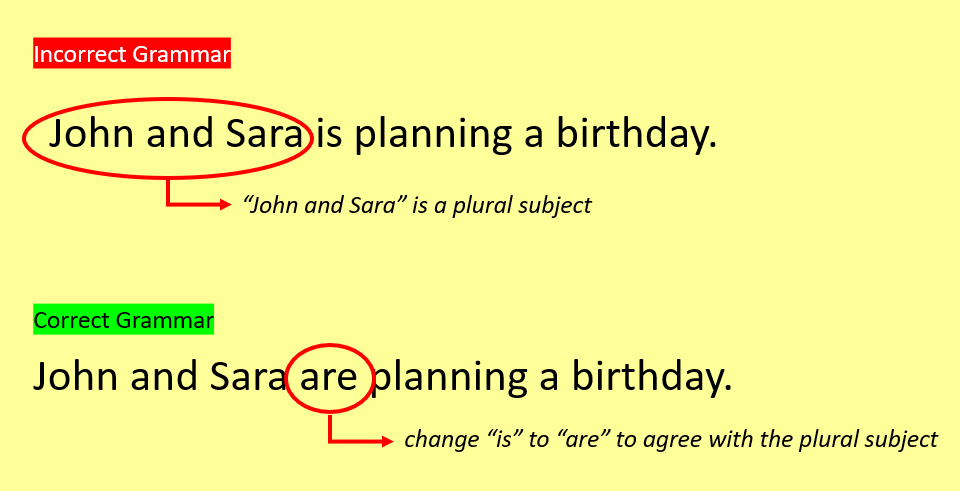Writers should know and follow basic grammar rules to communicate clearly through the written language.
Grammar is the set of rules by which we communicate. English grammar is those rules applied to the spoken and written English language. Writers need to know and follow basic grammar rules to communicate clearly through written language.
Grammar is governed by five overarching rules. These aren’t grammar “rules” like how to place periods and use conjunctions. They are the rules that serve as building blocks for English grammar.
- Phonology – The sounds that make up the words in a language
- Morphology – The minimal unit of meaning in a language
- Syntax – The way words are placed and combined to create meaning
- Semantics – The actual meaning of the words and sentences used to create language
- Pragmatics – idioms, figurative language, and other forms of more abstract communication that make language meaningful
Most basic grammar rules focus on semantics and syntax, but all five rules of language are important. This article explains more with common examples to help you with effective writing.
Contents
- 1. Write in Active Voice
- 2. Join Two Ideas with a Semicolon, Comma, or Conjunction
- 3. Use Correct Subject and Verb Agreement
- 4. Ensure A Sentence Has a Subject, Verb and Object
- 5. Apply the Apostrophe Appropriately
- 6. Understand When to Capitalize
- 7. Understand Articles
- 8. Use Correct Punctuation
- 9. Use Singular and Plural Nouns Correctly
- Master Basic English Grammar Rules
- Author
|
5.0
|
4.5
|
|
$30 per month
|
$79 per year
|
1. Write in Active Voice
Recognizing and writing in active voice is one of the first grammar rules to embrace. When you use a verb, choose the active tense of that verb. The subject of the sentence should be acting, not having the action done to it.
The opposite of active voice is passive voice. Passive voice occurs when you pair a being verb with a past tense action verb, such as “The apple was peeled by mom.”
In this sentence, Mom is doing the action, but the apple is the subject, so the writer uses the passive voice. Here’s an example of how to change a sentence from passive to active voice:
Instead of saying, “The dog was walked by his owner,” say, “The man walked his dog.”
2. Join Two Ideas with a Semicolon, Comma, or Conjunction
If you’re joining two ideas into one complete sentence, do so properly. One way is with a semicolon. This should be used only when the two ideas are closely linked.
The man has to walk his dog every day; Rover destroys furniture if he doesn’t get enough exercise.
You can also join them with a comma and coordinating conjunction, such as:
The man has to walk his dog every day, for it has a lot of energy.
Finally, you can drop the comma and join them with just a conjunction if you use a subordinating conjunction.
The man has to walk his dog every day since it has a lot of energy.
3. Use Correct Subject and Verb Agreement

Every sentence has a subject and a predicate, also known as a verb clause. Both nouns and verbs have a number, and they must agree.
With a plural subject, you must use the plural form of your verb. A singular subject requires the singular verb form. For example, consider this sentence structure:
John goes to the store.
This is correct because “John” and “Goes” are both singular words.
However, consider this sentence:
“John go to the store” is incorrect because “go” is plural.
“John and I go to the store” is correct because John and I is a plural subject.
Subject and verb agreement gets trickier when you have a subject combined by “or” or “nor.” In this case, only the subject closest to the verb is counted for number.
“Neither Phil nor Alice was available” is correct because the conjunction “nor” means the subject is singular.
4. Ensure A Sentence Has a Subject, Verb and Object
The most basic building block of written language is the sentence. To make a sentence, you need a subject and a verb. You also need one complete thought or object.
Sentences start with capital letters and end with a period, exclamation point, or question mark. You can form one with a group of words, two words, and sometimes even one.
For example:
He ran.
Here the subject is “he,” and the verb is “ran.” It is a complete thought, so it is a sentence.
Go!
This is also a sentence. The subject is an understood you. Therefore, it is a complete thought.
5. Apply the Apostrophe Appropriately
Apostrophes have two basic uses. First, they’re used to show possession. For example:
Kim’s cat ran out the door when she opened it for the mailman.
In this case, the apostrophe and the “s” show that the cat belongs to Kim. If a word is plural, an apostrophe with no “s” is used to show possession.
The kids’ parents went out for a date.
Apostrophes are also used to show missing letters when creating a conjunction. They’re, it’s, can’t, are all examples where the apostrophe shows the two words were joined.
6. Understand When to Capitalize
Capital letters are sometimes tricky. One of the most common reasons to capitalize is when you are writing a proper noun.
Proper nouns include:
- Names
- Specific places
- Words of address, such as “Could you get my bag, Mom?”
- Days of the week
- Months of the year
- Job titles used as part of a name or proceeding a name, such as “Secretary of State Michael R. Pompeo.”
In addition, you also need to capitalize the words in a book or article title, with the exception of conjunctions and prepositions that are three letters or fewer.
For example, “Around the World in 80 Days” is the correct way to capitalize the classic book’s title.
7. Understand Articles
A, an , and the are little words known as articles. They are used as adjectives to describe nouns and set nouns apart. The is used as a definite article. If you’re talking about a specific item, this article is correct.
He finally received the letter he had been hoping to get.
In this sentence, the subject wanted to receive this specific letter. A and an are indefinite articles. They’re used when the speaker or writer is talking about a more general noun. A is used when the noun starts with a consonant, while an is used if it starts with a vowel.
Both a and an are singular articles.
Please pass a roll.
May I have an orange?
If you need a modifier for a plural subject, you would use the word “some.”
May I have some jelly?
8. Use Correct Punctuation
Nothing screams amateur hour more than using incorrect punctuation. Every sentence should begin with a capital letter and conclude with a full-stop. Remember to capitalise peoples’ names too.
Writers should end a sentence with a question mark or exclamation mark, although only use the former if it’s a question and the later sparingly.
Here is an example:
My editors name is Bill. He is a good boss.
That should read:
My editor’s name is Bill. He is a good boss.
For help with this basic grammar rule, read our guide to the best punctuation checkers.
9. Use Singular and Plural Nouns Correctly
It’s easy to mix up singular and plural nouns. The former refers to one person, place, thing , or idea. The latter refers to many places, things, or ideas. Usually, a writer uses the word is for singular nouns and the word are for plural nouns. They also need to change apostrophes accordingly.
For example, consider:
The girls’ jackets is in the wash.
That should read
The girls’ jackets are in the wash.
For more advice about this grammar rule, read our guide to is versus are.
Master Basic English Grammar Rules
These are just nine out of thousands of basic English grammar rules that dictate how people write. Grammar checkers like Grammarly can help you see mistakes you might have missed. They provide context behind these rules while analyzing your writing. Why not avail of a Grammarly coupon?
Proofreading software can also help if you want to learn English faster. Using these tools, or a good grammar book, will help you eliminate errors and write more clearly.
We tested dozens of grammar checkers, and Grammarly is the best tool on the market today. It'll help you write and edit your work much faster. Grammarly provides a powerful AI writing assistant and plagiarism checker.



